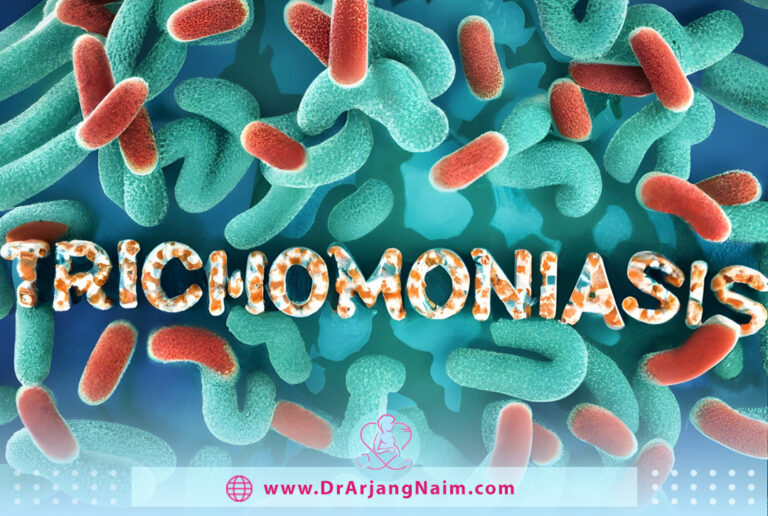Trichomoniasis is a sexually transmitted infection caused by a parasite. It affects the genital area and can cause symptoms like itching, unusual discharge, and discomfort during sex or urination. It’s easily treatable with antibiotics, and using protection during sex helps prevent its spread. Testing and treatment for both partners are essential to avoid reinfection.

What are the symptoms of trichomoniasis?
Trich often has no symptoms. The CDC reports that only 30 percent of contract trich report symptoms. In one study, 85 percent of affected women had no symptoms. When symptoms do appear, they often begin 5 to 28 days after a person has contracted the disease. For some people, it may take much longer. The most common symptoms among people with vaginal infections are:
- Vaginal discharge that can be white, gray, yellow, or green and usually frothy with an unpleasant smell
- Vaginal spotting or bleeding
- Burning or itching of the genital area
- Redness or swelling of the genital area
- Frequent urge to urinate
- Pain during urination or sexual intercourse
The most common symptoms in people with genital warts are:
- Urethral discharge
- Burning during urination or after ejaculation
- Desire to urinate frequently
Causes
Trichomoniasis, caused by the parasite Trichomonas vaginalis, primarily affects the genital area. It can lead to symptoms such as:
- Genital Discomfort: Itching, burning, or irritation in the genital region.
- Unusual Discharge: Women may experience frothy, greenish-yellow vaginal discharge, while men might notice discharge from the penis.
- Painful Urination or Sex: Discomfort or pain during urination or sexual intercourse can occur.
- Possible Abdominal Discomfort: Some individuals may experience lower abdominal pain or discomfort.
It’s important to note that some people infected with trichomoniasis might not display any symptoms, making regular STI testing crucial, especially for those sexually active or at higher risk.
Risk factors
Several factors can increase the risk of contracting trichomoniasis:
- Unprotected Sexual Activity: Engaging in unprotected sex, including vaginal, oral, or anal sex, increases the risk of contracting trichomoniasis.
- Multiple Sexual Partners: Having multiple sexual partners or having a partner who has multiple partners increases the likelihood of exposure to STIs, including trichomoniasis.
- Previous Infections: If previously diagnosed and treated for trichomoniasis, there’s a potential risk of reinfection if exposed again.
- Age and Gender: Women are more susceptible to trichomoniasis than men, and younger individuals might have a higher risk due to more sexually active behaviors.
- Immunocompromised Conditions: People with weakened immune systems due to certain illnesses or medications might be more susceptible to contracting trichomoniasis and experience more severe symptoms.
Understanding these risk factors can help individuals take preventive measures, such as practicing safe sex and undergoing regular STI screenings, to minimize the risk of trichomoniasis and other sexually transmitted infections.
Complications of this condition
Untreated HIV increases the risk of contracting the human immunodeficiency virus (HIV) if exposed to the virus. Untreated HIV can lead to AIDS. AFAB women and men who have trich and HIV are more likely to transmit both diseases to their partners. For this reason, the Centers for Disease Control and Prevention (CDC) recommends that HIV-positive women and AFAB individuals be tested at least once a year.
Trichomoniasis prevention
Preventing trichomoniasis involves a few key strategies.
Safe sexual practices
Using condoms correctly and consistently during sexual activity (including vaginal, anal, and oral sex) reduces the risk of contracting trichomoniasis. However, while condoms can lower the risk, they may not provide complete protection as the parasite can infect areas not covered by the condom.
Regular STI testing
Getting tested for STIs, including trichomoniasis, if sexually active or if there’s a change in sexual partners, helps detect infections early and facilitates timely treatment.
Mutual monogamy
Being in a mutually monogamous relationship with a partner who has tested negative for STIs can reduce the risk of contracting trichomoniasis.
Prompt treatment
If diagnosed with trichomoniasis, completing the prescribed course of antibiotics and informing sexual partners for testing and treatment is crucial to prevent reinfection.
General hygiene
Maintaining good personal hygiene practices can also contribute to overall sexual health. This includes regular bathing and washing the genital area before and after sexual activity.
Remember, since trichomoniasis might not always show symptoms, it’s important for both partners to get tested and treated, if necessary, even in the absence of noticeable symptoms, to prevent the spread of the infection.

Diagnosed
Trichomoniasis is typically diagnosed through a few methods:
- Physical Examination: Healthcare providers might perform a pelvic exam in women or a visual examination in men to check for any signs of infection, such as unusual discharge or genital irritation.
- Laboratory Tests: The most common method is through laboratory testing, which involves collecting a sample of vaginal fluid for women or urethral swabs for men. This sample is then examined under a microscope to detect the presence of the Trichomonas vaginalis parasite. Additionally, nucleic acid amplification tests (NAATs) can detect the parasite’s genetic material and are highly sensitive and specific for diagnosis.
- Testing Both Partners: If one partner is diagnosed with trichomoniasis, it’s recommended for both partners to undergo testing and, if necessary, treatment, even if the other partner doesn’t display symptoms. This helps prevent reinfection and ensures both individuals are free from the infection.
Early diagnosis is essential to prevent the spread of the infection and its potential complications. If there’s a concern about a possible trichomoniasis infection, seeking medical advice and testing is important.

Treatment
Trichomoniasis is usually treated with antibiotics, most commonly metronidazole (Flagyl) or tinidazole. A single dose or a week-long course of antibiotics is typically prescribed to clear the infection. It’s important to complete the entire course of medication, even if symptoms improve, to ensure the infection is fully treated.
During treatment and for at least a week after completing the antibiotics, it’s advisable to avoid alcohol consumption as it can cause unpleasant side effects when combined with certain antibiotics, such as metronidazole.
Additionally, sexual partners should also be treated simultaneously to prevent reinfection and reduce the risk of transmission. It’s recommended to abstain from sexual activity until both partners have completed their treatment and have been cleared by a healthcare professional.
Regular follow-up testing after treatment might be recommended to confirm that the infection has cleared completely. If symptoms persist or recur after treatment, seeking medical advice for further evaluation is important.
Outlook for someone with trichomoniasis
The outlook for someone with trichomoniasis is generally good with prompt and proper treatment.
With timely diagnosis and completion of the prescribed antibiotic course, most individuals recover fully from trichomoniasis without experiencing any long-term complications. Symptoms usually improve within a few days to a week after starting treatment.
However, if left untreated, trichomoniasis can persist and potentially lead to complications, particularly in pregnant women, such as preterm birth or low birth weight. In addition, having trichomoniasis might also increase susceptibility to acquiring other sexually transmitted infections (STIs) like HIV.
The key to a positive outlook is early detection, adherence to prescribed treatment, ensuring both partners are treated simultaneously, and abstaining from sexual activity until cleared by a healthcare provider. Regular STI screenings, especially for those at higher risk, can also aid in preventing and managing trichomoniasis effectively.
The bottom line
Trichomoniasis is a very common and treatable infection. Millions of people are diagnosed with trich every year. It spreads easily because most people have no symptoms and are unaware they are contagious. Follow your healthcare provider’s instructions when taking medications to treat an infection. Stopping treatment too soon or having sex before the infection clears can lead to reinfection. Your healthcare provider can also make suggestions for preventing STDs in the future.
Additional questions
- Is trichomoniasis a female STD?
Trichomoniasis is not exclusively a female sexually transmitted infection (STI), although it tends to cause more noticeable symptoms in women compared to men. Both men and women can contract trichomoniasis through sexual activity.
- Is trichomoniasis a type of chlamydia?
Trichomoniasis and chlamydia are two distinct sexually transmitted infections (STIs) caused by different organisms and requiring different treatments.
Trichomoniasis is caused by a parasite called Trichomonas vaginalis, while chlamydia is caused by Chlamydia trachomatis. These infections have different characteristics.
- What are the five types of sexually transmitted infections?
Eight pathogens are associated with the highest prevalence of STIs. Of these, four are currently treatable:
- Syphilis
- Gonorrhea
- Chlamydia
- Trichomoniasis
- How long can STDs live on the skin?
Sexually transmitted disease (STD) pathogens have varying lifespans on skin surfaces, from a few seconds to several days. Herpes simplex virus (HSV) can last from seconds to hours, while HIV is relatively fragile and becomes inactive quickly when exposed to air. Hepatitis B virus (HBV) can persist for several days, but bacterial STDs like syphilis or gonorrhea typically don’t survive long on the skin. Direct skin-to-skin contact during sexual activity remains a primary mode of transmission for most STDs, emphasizing the importance of using protection, practicing good hygiene, and seeking timely medical advice for concerns about STD exposure.
- Can a Yeast Infection Cause Bleeding?
Yes, a yeast infection can cause bleeding sometimes, but it’s not very common. Vaginal yeast infections, caused by an overgrowth of Candida fungus, typically lead to symptoms such as itching, a thick white discharge resembling cottage cheese, and irritation around the vaginal area.
However, severe or prolonged yeast infections might cause irritation and inflammation in the vaginal tissues, leading to tiny tears or fissures, which could result in bleeding. Additionally, excessive scratching or rubbing due to the discomfort caused by the infection might contribute to minor bleeding.
References
https://www.mayoclinic.org/diseases-conditions/trichomoniasis/diagnosis-treatment/drc-20378613
https://my.clevelandclinic.org/health/diseases/4696-trichomoniasis#diagnosis-and-tests
https://www.webmd.com/sexual-conditions/trichomoniasis#1-6
https://www.healthline.com/health/trichomoniasis#diagnosis
https://www.betterhealth.vic.gov.au/health/conditionsandtreatments/trichomoniasis
https://www.medicalnewstoday.com/articles/307896
https://www.health.com/trichomoniasis-overview-7105164
https://www.verywellhealth.com/can-yeast-infection-cause-bleeding-5176673




